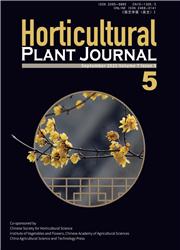Reduced CHH methylation levels reveal a critical role of aging pathway genes in Moso bamboo flowering
IF 5.7
1区 农林科学
Q1 HORTICULTURE
引用次数: 0
Abstract
Moso bamboo holds significant economic importance in China, serving various purposes, such as food, material, ornamentation, and greenery. Despite its versatility, the occurrence of flowering in Moso bamboo poses a threat to bamboo forests, resulting in substantial losses. The underlying cause of bamboo flowering remains elusive. Dynamic fluctuations in DNA methylation govern the transcriptional levels of crucial genes pivotal for plant growth and development. In this study, we conducted comprehensive DNA methylation (by whole-genome bisulfite sequencing) and transcriptome (by RNA-seq) analyses on non-flowering leaves, flowering leaves, and spikelets of Moso bamboo. Our findings revealed a notable reduction in the overall DNA methylation level, particularly CHH methylation, from leaves to spikelets, influencing the expression of differentially regulated genes. Notably, we identified DNA methylation as a regulatory mechanism for numerous flowering-related genes, including , , and . Specifically, the gene, a key regulator of the aging pathway, exhibited hypomethylation and a high expression level in spikelets. Conversely, displayed transcriptional silencing attributed to hypermethylation in the CHH context in the leaves of non-flowering plants. DNA methylation may affect the flowering mechanism of Moso bamboo by regulating the expression of key genes. In summary, our results shed light on the dynamic changes in DNA methylation between leaves and spikelets, unraveling an important epigenetic modification mechanism for flowering in Moso bamboo.CHH 甲基化水平降低揭示了衰老途径基因在毛竹开花中的关键作用
毛竹在中国具有重要的经济价值,可用于食品、材料、装饰和绿化等多种用途。尽管毛竹用途广泛,但毛竹开花对竹林构成威胁,造成巨大损失。竹子开花的根本原因仍然难以捉摸。DNA 甲基化的动态波动控制着植物生长和发育关键基因的转录水平。在这项研究中,我们对毛竹的非开花叶片、开花叶片和小穗进行了全面的 DNA 甲基化(通过全基因组亚硫酸氢盐测序)和转录组(通过 RNA-seq)分析。我们的研究结果表明,从叶片到小穗,整体DNA甲基化水平显著降低,尤其是CHH甲基化,影响了不同调控基因的表达。值得注意的是,我们发现DNA甲基化是许多开花相关基因的调控机制,包括 、 和 。具体来说,该基因是衰老途径的关键调控因子,在小穗中表现出低甲基化和高表达水平。相反,在非开花植物的叶片中,由于 CHH 上下文的高甲基化,显示了转录沉默。DNA甲基化可能通过调节关键基因的表达来影响毛竹的开花机制。总之,我们的研究结果揭示了叶片和小穗之间DNA甲基化的动态变化,揭示了毛竹开花的重要表观遗传修饰机制。
本文章由计算机程序翻译,如有差异,请以英文原文为准。
求助全文
约1分钟内获得全文
求助全文
来源期刊

Horticultural Plant Journal
Environmental Science-Ecology
CiteScore
9.60
自引率
14.00%
发文量
293
审稿时长
33 weeks
期刊介绍:
Horticultural Plant Journal (HPJ) is an OPEN ACCESS international journal. HPJ publishes research related to all horticultural plants, including fruits, vegetables, ornamental plants, tea plants, and medicinal plants, etc. The journal covers all aspects of horticultural crop sciences, including germplasm resources, genetics and breeding, tillage and cultivation, physiology and biochemistry, ecology, genomics, biotechnology, plant protection, postharvest processing, etc. Article types include Original research papers, Reviews, and Short communications.
文献相关原料
| 公司名称 | 产品信息 | 采购帮参考价格 |
|---|
 求助内容:
求助内容: 应助结果提醒方式:
应助结果提醒方式:


